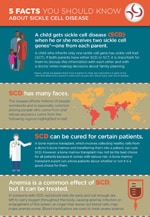What is Sickle Cell Disease?

Sickle cell disease (SCD) is a group of inherited red blood cell disorders. Red blood cells contain hemoglobin, a protein that carries oxygen. Healthy red blood cells are round, and they move through small blood vessels to carry oxygen to all parts of the body. In someone who has SCD, the hemoglobin is abnormal, which causes the red blood cells to become hard and sticky and look like a C-shaped farm tool called a “sickle.” The sickle cells die early, which causes a constant shortage of red blood cells. Also, when they travel through small blood vessels, they get stuck and clog the blood flow. This can cause pain and other serious complications (health problems) such as infection, acute chest syndrome and stroke.
Types of SCD
There are several types of SCD. The specific type of SCD a person has depends on the genes they inherited from their parents. People with SCD inherit genes that contain instructions, or code, for abnormal hemoglobin.
Below are the most common types of SCD:
HbSS
People who have this form of SCD inherit two genes, one from each parent, that code for hemoglobin “S.” Hemoglobin S is an abnormal form of hemoglobin that causes the red cells to become rigid, and sickle shaped. This is commonly called sickle cell anemia and is usually the most severe form of the disease.
HbSC
People who have this form of SCD inherit a hemoglobin “S” gene from one parent and a gene for a different type of abnormal hemoglobin called “C” from the other parent. This is usually a milder form of SCD.
Did you know SCD affects people from many parts of the world?
HbS beta thalassemia
People who have this form of SCD inherit a hemoglobin “S” gene from one parent and a gene for beta thalassemia, another type of hemoglobin abnormality, from the other parent. There are two types of beta thalassemia: “zero” (HbS beta0) and “plus” (HbS beta+). Those with HbS beta0-thalassemia usually have a severe form of SCD. People with HbS beta+-thalassemia tend to have a milder form of SCD.
There also are a few rare types of SCD, such as the following:
HbSD, HbSE, and HbSO
People who have these forms of SCD inherit one hemoglobin “S” gene and one gene that codes for another abnormal type of hemoglobin (“D”, “E”, or “O”). The severity of these rarer types of SCD varies.
Sickle Cell Trait (SCT)
HbAS
People who have sickle cell trait (SCT) inherit a hemoglobin “S” gene from one parent and a normal gene (one that codes for hemoglobin “A”) from the other parent. People with SCT usually do not have any of the signs of the disease. However, in rare cases, a person with SCT may develop health problems; this occurs most often when there are other stresses on the body, such as when a person becomes dehydrated or exercises strenuously. Additionally, people who have SCT can pass the abnormal hemoglobin “S” gene on to their children.
Learn more about sickle cell trait »
Cause of SCD
SCD is a genetic condition that is present at birth. It is inherited when a child receives two genes—one from each parent—that code for abnormal hemoglobin.
Diagnosis
SCD is diagnosed with a simple blood test. In children born in the United States, it most often is found at birth during routine newborn screening tests at the hospital. In addition, SCD can be diagnosed while the baby is in the womb. Diagnostic tests before the baby is born, such as chorionic villus sampling and amniocentesis, can check for chromosomal or genetic abnormalities in the baby. Chorionic villus sampling tests a tiny piece of the placenta, called chorionic villus. Amniocentesis tests a small sample of amniotic fluid surrounding the baby.
Because children with SCD are at an increased risk of infection and other health problems, early diagnosis and treatment are important.
Talk to your doctor to find out how to get tested and to explain the results after testing.
Complications
People with SCD may start to have signs of the disease during the first year of life, usually around 5 months of age. Symptoms and complications of SCD are different for each person and can range from mild to severe. Learn about the complications.
Prevention and Treatment of SCD Complications
General Prevention Strategies
Management of SCD is focused on preventing and treating pain episodes and other complications. Prevention strategies include lifestyle behaviors as well as medical screening and interventions to prevent SCD complications.
Lifestyle Behaviors
There are simple steps that people with SCD can take to help prevent and reduce the occurrence of pain crises, including the following:
- Drink plenty of water.
- Try not to get too hot or too cold.
- Try to avoid places or situations that cause exposure to high altitudes (for example, flying, mountain climbing, or cities with a high altitude).
- Try to avoid places or situations with exposure to low oxygen levels (for example, mountain climbing or exercising extremely hard, such as in military boot camp or when training for an athletic competition).
Simple steps to prevent harmful infections include the following:
- Wash your hands often. Washing hands with soap and clean water many times each day is one of the best ways people with SCD, their family members, and other caregivers can help prevent an infection.
- Prepare food safely. Bacteria can be especially harmful to children with SCD.
Medical Screenings & Interventions to Prevent SCD Complications
Prevention of Infections
- Vaccines can protect against harmful infections. It is important that children with SCD get all regular childhood vaccines. Similarly, it is important for children and adults to get the flu vaccine every year, as well as the pneumococcal vaccine and any others recommended by a doctor.
- Penicillin greatly reduces the risk of infections in people with HbSS and has been shown to be even more effective when it is started earlier. To decrease the risk of infection, it’s important that young children with HbSS take penicillin (or other antibiotic prescribed by a doctor) every day until at least 5 years of age. Penicillin on a daily basis is usually not prescribed for children with other types of SCD unless the severity of the disease is similar to that of HbSS, such as HbS beta0-thalassemia.
Prevention of Vision Loss
- Yearly visits to an eye doctor to look for damage to the retina (the part of your eye that senses light and sends images to your brain) are important for people with SCD to avoid vision loss. If possible, it’s best to see an eye doctor who specializes in diseases of the retina.
- If the retina is damaged by excessive blood vessel growth, laser treatment often can prevent further vision loss.
Prevention of Stroke
- Children who are at risk for stroke can be identified using a special type of exam called transcranial Doppler ultrasound (TCD). If the child is found to have an abnormal TCD, a doctor might recommend frequent blood transfusions (a procedure in which new blood is put into a person’s body through a small plastic tube inserted into a person’s blood vessels) to help prevent a stroke.
- People who have frequent blood transfusions are usually watched closely because there can be serious side effects. For example, because blood contains iron, transfusions can lead to a condition called iron overload, in which too much iron builds up in the body. Iron overload can cause life-threatening damage to the liver, heart, and other organs. Therefore, it is important for people with SCD receiving regular blood transfusions to also receive treatment to reduce excess iron in the body. This type of treatment is known as iron chelation therapy.
Prevention of Severe Anemia
- Blood transfusions may be used to treat severe anemia. A sudden worsening of anemia resulting from infection or enlargement of the spleen (an organ in the upper left side of the abdomen) is a common reason for a transfusion.
- As with preventing stroke, frequent blood transfusions can cause iron overload, and iron chelation therapy may be needed to reduce excess iron in the body.
Management of Pain Crises
When pain crises do occur, clinical management may include the following:
- Intravenous fluids (giving fluids directly into a person’s vein)
- Pain-reducing medicine
- Hospitalization for severe pain crises
Specific Treatments to Prevent SCD Complications
SCD is a disease that worsens over time. Treatments are available that can prevent complications and lengthen the lives of those who have this condition. These treatment options and their effects can be different for each person, depending on the symptoms and severity of their disease. It is important to understand the benefits and risks of each treatment option. Currently, the FDA has approved four treatments for SCD[1].
- Hydroxyurea (pronounced “hi-DROK-see-yoo-REE-uh”) may help people with SCD ages 2 years and older. More information about hydroxyurea can be found here.
- L-glutamine (pronounced “L-gloo-ta-meen,”), or ENDARI® may help people with SCD ages 5 years and older. More information about L-glutamine can be found on page 2 here.
- Voxelotor (pronounced “vox-EL-o-tor”), or OXBRYTA® may help people with SCD ages 4 years and older. More information about Voxelotor can be found on the FDA website here.
- Crizanlizumab (pronounced “criz-an-liz-u-mab”), or ADAKVEO® may help people with SCD ages 16 years and older. More information about Crizanlizumab can be found on page 1 here.
Several other treatments and therapies for SCD have recently been developed that are still undergoing clinical trials and thus have not yet been approved by the FDA.
Cure
The only therapy approved by the FDA that may be able to cure SCD is a bone marrow or stem cell transplant.
Bone marrow is a soft, fatty tissue inside the center of the bones, where blood cells are made. A bone marrow or stem cell transplant is a procedure that takes healthy cells that form blood from one person—the donor—and puts them into someone whose bone marrow is not working properly.
Bone marrow or stem cell transplants are very risky and can have serious side effects, including death. For the transplant to work, the bone marrow must be a close match. Usually, the best donor is a brother or sister. Bone marrow or stem cell transplants are most common in cases of severe SCD for children who have minimal organ damage from the disease.
Find clinical treatment guidelines for providers as well as patient and family resources derived from clinical treatment guidelines:
For Healthcare Providers
- Evidence-Based Management of Sickle Cell Disease: Expert Panel Report, 2014, National Heart, Lung, and Blood Institute
- Clinical Practice Guidelines on Sickle Cell Disease, American Society of Hematology
For People with SCD and their Families
[1] CDC will periodically review and update this treatment list when new treatments are approved by the FDA.

